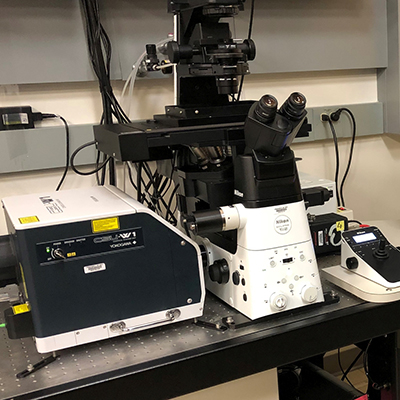Nikon Spinning Disk - TIRF - STORM

The Nikon is a hybrid instrument offering spinning disk confocal imaging and Total Internal reflection Fluorescence (TIRF) microscopy.
The spinning disk system is based on a Yokogawa CSU-W1 scanning unit with a large field of view ideally suited for large tissue sections in tiled mode.
TIRF illuminates a 100nm layer at the glass / water interface and is the technique of choice for membrane-bound events such as docking, diffusion, endo- and exo-cytosis. The rotating TIRF unit is based on an ILAS scanning unit that offers high-quality TIRF images.
The Nikon Eclipse Ti2 microscope stand is equipped with an autofocus device and a full stage-top incubator, and is suitable for long-term experiments on live cells.
Laser lines: 405, 488, 561 and 640 nm
Confocal scanner: Yokogawa CSU-W1
Objectives: 10x/0.45 CFI PlanApo, , 20x/0.75 CFI PlanApo VC, 40x/1.3 CFI PlanFluor (oil), 60x/1.4 CFI PlanApo Lambda (oil), 100x/1.49* CFI Apo TIRF(oil)
(*the100x/1.49 TIRF lens is stored separately, contact staff in advance of your TIRF experiment)
Spinning disk emission filters: 430-480 nm, 450-500 nm, 505-543 nm, 530-580 nm, 570-640 nm, 660-740 nm, dual Fitc/Rhod, dual GFP/mCherry
TIRF emission filters: 450-500 nm, 500-550 nm, 530-580 nm, 575-625 nm, 670-740 nm, dual Fict/Rhod, dual GFP/mCherry
Spinning disk camera: 95% QE Photometrics Prime 95 cmos, 1200x1200 11um pixels, 40fps max.
TIRF Camera: Low-noise Hamamatsu Orca Fusion cmos 80% QE, 2304x2304 6.5um pixels.
 BACK TO TOP
BACK TO TOP